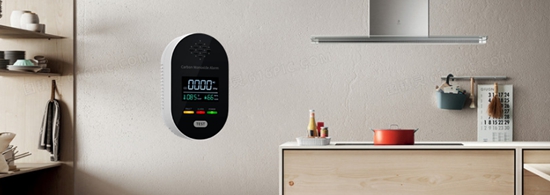The Lifesaving Role of Carbon Monoxide Detectors in Hot Summer Kitchens
As temperatures soar, kitchen risks escalate. Carbon monoxide (CO) – an odorless, invisible gas produced by incomplete combustion – becomes a silent killer in enclosed spaces. Here’s how carbon monoxide detectors protect your family during summer’s peak heat, backed by real-world examples:
① The Overworked Grill Dilemma
Scenario: Running a gas grill indoors during a sudden summer storm.
Risk: Grills emit high concentrations of CO – a single hour of operation indoors can release over 100ppm (lethal within 90 mins)1.
Detector Action: Alarms blare at 30ppm, prompting immediate ventilation and shutdown.
② Air Conditioning + Gas Stove Combo Hazard
Scenario: Sealing kitchens to retain AC cold while cooking.
Risk:* Reduced oxygen increases incomplete combustion. Studies show CO levels spike 400% in air-tight summer kitchens3.
Detector Response: Electrochemical sensors trigger alerts before CO reaches 10% blood saturation (headache/fatigue stage)[4.
③ Generator Backup During Blackouts
Scenario: Using portable generators near kitchen windows during power outages.
Deadly Fact: Just 5% generator exhaust entering a window can cause CO poisoning in 15 minutes2.
Detector Intervention: Continuous monitoring detects trace leaks (< 50ppm) undetectable to humans.
Why Summer Aggravates CO Risks
High humidity slows gas dispersion
Thermal inversion traps CO near ground level
Frequent appliance use (fridges/freezers working harder) strains electrical systems
Optimizing Your Carbon Monoxide Detector for Summer
Placement: Install within 3m of cooking appliances but away from direct airflow4
Upgrade to Smart Models: Get phone alerts when away from home
Monthly Testing: Heat reduces sensor sensitivity – validate with CO test sprays
Ventilation Synergy: Pair detectors with range hoods running at > 100 CFM
Pro Tip: Choose carbon monoxide detectors with 10-year electrochemical sensors that withstand high humidity.
Key Statistics That Demand Action
50% of CO poisoning deaths occur July-September (CDC)
Kitchens contribute to 23% of home CO leaks
Detectors reduce mortality risk by 93% (Journal of Emergency Medicine)
Regular maintenance checks are non-negotiable – a malfunctioning furnace during heatwaves can emit lethal CO within minutes3. Your summer kitchen isn’t just a cooking space; it’s a potential hazard zone where a $40 carbon monoxide detector could rewrite a family’s future.
-
 Why Your Carbon Monoxide Detector is Essential During Hot Summer
Why Your Carbon Monoxide Detector is Essential During Hot SummerDo you like ?0
Read more -
 The Silent Killer at Home: Why Your Carbon Monoxide Detector is a Lifesaver
The Silent Killer at Home: Why Your Carbon Monoxide Detector is a LifesaverDo you like ?0
Read more -
 Carbon Monoxide Detector: Your Essential Guardian Against Silent Winter Threats
Carbon Monoxide Detector: Your Essential Guardian Against Silent Winter ThreatsDo you like ?0
Read more -
 What Are the Signs of Carbon Monoxide in the House?
What Are the Signs of Carbon Monoxide in the House?Do you like ?0
Read more -
 Where Should a Carbon Monoxide Detector Be Placed?
Where Should a Carbon Monoxide Detector Be Placed?Do you like ?0
Read more -
 What Are Carbon Monoxide Detectors Used For?
What Are Carbon Monoxide Detectors Used For?Do you like ?0
Read more









